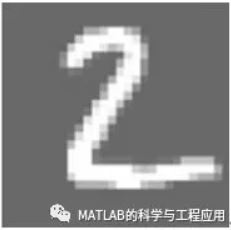屏幕显示的第一幅图像是下面的28×28输入图像“2”,如图6-20所示。
The first image that the screen shows isthe following 28×28 inputimage of a 2, as shown in Figure 6-20.

图6-20 屏幕显示的第一幅图像The first image shown
图6-21是屏幕显示的第二幅图像,由20个训练的卷积滤波器组成。
Figure 6-21 is the second image of thescreen, which consists of the 20 trained convolution filters.

图6-21 显示20个训练卷积滤波器的图像Image showing 20 trained convolution filters
每个滤波器就是一幅像素图像,并将元素值以灰度显示。
Each filter is pixel image and shows theelement values as grayscale shades.
像素值越大,显示的亮度越高。
The greater the value is, the brighter theshade becomes.
这些滤波器是由ConvNet确定的最佳特征,可以从MNIST图像中提取出来。

These filters are what ConvNet determinedto be the best features that could be extracted from the MNIST image.
你认为怎样呢?
What do you think?
你从中看到数字的一些独特的特征了吗?
Do you see some unique features of thedigits?
图6-22是来自屏幕的第三幅图像,它是卷积层的图像处理结果(y1)。
Figure 6-22 is the third image from thescreen, which provides the results (y1) of the image processing of theconvolution layer.

图6-22 卷积层图像处理的结果(y1)The results (y1) of the imageprocessing of the convolution layer
该特征映射由20幅20×20像素图像组成。
This feature map consists of 20 20×20 pixel images.
由卷积滤波器引起的输入图像的各种变化可以从这幅图中看出。
The various alterations of the input imagedue to the convolution filter can be noticeable from this figure.
图6-23所示的第四幅图像是ReLU函数在卷积层的特征映射上处理后的图像。
The fourth image shown in Figure 6-23 iswhat the ReLU function processed on the feature map from the convolution layer.
——本文译自Phil Kim所著的《Matlab Deep Learning》
更多精彩文章请关注微信号: